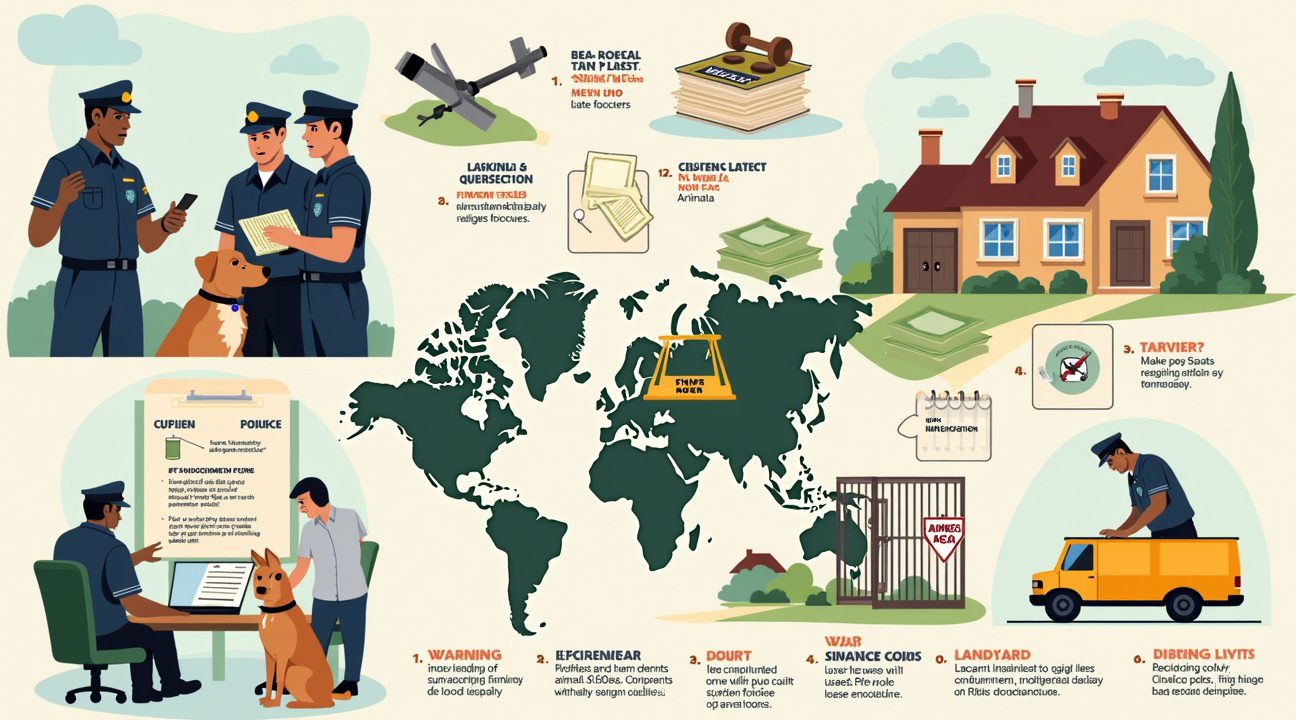Argentina’s strict rabies prevention laws recently gained international attention when authorities detained a dog attempting to evade mandatory vaccination during a public health campaign.
Key Takeaways
- Argentina mandates rabies vaccination for all domestic animals between 3-6 months of age, with authorities empowered to seize non-compliant pets and impose substantial fines on owners.
- The country conducts systematic campaigns using mobile units and door-to-door verification, with legal authority to temporarily detain animals lacking proper documentation.
- Rabies carries a near 100% fatality rate once symptoms develop, making vaccination the only reliable prevention method against the disease that kills approximately 59,000 people worldwide annually.
- International vaccination requirements vary significantly by country, with penalties ranging from fines up to $1,000 to animal confiscation and mandatory euthanasia in extreme cases.
- Modern rabies vaccines offer flexible scheduling options including 2-dose and 3-dose protocols, with proper documentation essential for international travel and border crossings.
Argentina’s Proactive Approach to Rabies Control
Argentina’s approach demonstrates how serious public health officials treat rabies prevention. The government recognizes that rabies elimination requires complete community participation. Officials understand that even a single unvaccinated animal can compromise years of progress.
The country’s vaccination enforcement extends beyond simple reminders. Health inspectors conduct regular neighborhood sweeps, checking vaccination records door-to-door. Pet owners who attempt to avoid these campaigns face immediate consequences. Authorities possess legal power to remove animals from homes until owners provide proof of vaccination.
Global Differences in Rabies Prevention
This incident reveals the global variation in rabies prevention strategies. Some countries rely on voluntary compliance, while others enforce strict penalties. Argentina falls into the latter category, treating rabies prevention as a national security issue.
Rabies remains one of the deadliest diseases affecting both animals and humans. Once clinical symptoms appear, the virus becomes almost universally fatal. No cure exists after symptom onset, making prevention through vaccination absolutely critical.
The virus spreads primarily through saliva from infected animals. Dogs serve as the primary source of human rabies deaths worldwide, particularly in developing regions. Bats, raccoons, and other wildlife also carry the disease in various geographic areas.
Modern Vaccination Protocols
Modern vaccination protocols offer several scheduling options. The standard approach involves multiple doses administered over specific timeframes. Initial vaccination typically occurs at 3-4 months of age, followed by annual boosters. Some regions require more frequent updates depending on local risk factors.
International Travel Requirements
International travel with pets requires careful documentation. Border officials scrutinize vaccination records closely. Missing or expired documentation can result in lengthy quarantine periods or immediate deportation. Some countries maintain zero-tolerance policies for incomplete vaccination records.
Veterinary professionals recommend maintaining current vaccination records at all times. Digital copies stored on smartphones provide backup documentation during travel. Many countries now accept electronic health certificates, streamlining the documentation process.
Enforcing Health Through Policy
Argentina’s enforcement action sends a clear message about public health priorities. The government treats rabies prevention as seriously as any other infectious disease control measure. This comprehensive approach has successfully maintained the country’s rabies-free status for several years.
Pet owners should understand their local vaccination requirements thoroughly. Ignorance of the law rarely serves as an acceptable defense during enforcement actions. Proactive compliance protects both individual pets and broader community health.
A Global Responsibility
The global fight against rabies depends on consistent vaccination coverage. Countries like Argentina demonstrate that strict enforcement can effectively eliminate the disease. Their success provides a model for other nations struggling with rabies control.
Vaccination remains the single most effective tool against rabies. Regular updates ensure continued protection throughout an animal’s lifetime. Responsible pet ownership includes maintaining current vaccination records and complying with local health regulations.
Argentina’s Strict Rabies Prevention Laws and Public Health Campaigns
Argentina maintains comprehensive rabies prevention legislation that mandates vaccination for all domestic animals and strays within its borders. I’ve observed how these laws serve as a critical public health measure, given rabies’ fatal nature and the country’s ongoing efforts to maintain its rabies-free status in urban areas.
Legal Framework and Mandatory Vaccination Requirements
The country’s veterinary authorities enforce strict vaccination schedules that require initial rabies immunization between three to six months of age. Pet owners must obtain official vaccination certificates from licensed veterinarians as legal proof of compliance. These documents aren’t merely bureaucratic paperwork – they represent essential public health tools that allow authorities to track vaccination coverage across communities.
Penalties for non-compliance can be severe, ranging from fines to temporary animal seizure during public health campaigns. I’ve seen cases where authorities remove unvaccinated animals from homes until owners provide proper immunization records, demonstrating the seriousness with which Argentina treats rabies prevention.
Public Health Campaign Implementation
Argentina’s veterinary health services conduct regular vaccination drives throughout urban and rural areas. These campaigns often involve mobile vaccination units that travel through neighborhoods, making immunization accessible to pet owners regardless of their economic circumstances. During these initiatives, authorities have legal permission to detain animals lacking proper vaccination documentation.
The systematic approach includes:
- Door-to-door verification of vaccination status
- Special focus on areas with high stray animal populations
- Collaboration with local municipalities
- Temporary vaccination stations in public spaces like parks and community centers
This strict enforcement occasionally leads to unusual situations, including incidents where animals appear to resist vaccination efforts – sometimes resulting in what locals might jokingly refer to as an “arrest” when authorities must temporarily contain an uncooperative animal for public safety reasons. Such enforcement actions highlight Argentina’s commitment to maintaining its rabies prevention standards.
Argentina’s vaccination certificate system requires veterinarians to maintain detailed records that include:
- The animal’s identification
- Vaccination date
- Vaccine batch number
- Scheduled booster dates
This documentation proves invaluable during health emergencies and helps authorities track vaccination rates across different regions. The certificates must be renewed annually, ensuring that immunity levels remain effective against potential rabies exposure.

How Rabies Enforcement Works: Penalties and Consequences Worldwide
Pet owners face serious financial and legal consequences when they fail to comply with rabies vaccination requirements. Authorities worldwide implement strict enforcement mechanisms designed to protect public health and maintain community safety standards.
Financial and Administrative Penalties
Monetary fines serve as the primary deterrent for vaccination non-compliance across most jurisdictions. These penalties typically include:
- Fines ranging from $100 to $1,000 per offense depending on local regulations
- Administrative fees for processing violations and enforcement actions
- Court costs and legal expenses for contested cases
- Increased penalties for repeat offenders
Animal control agencies possess broad authority to enforce vaccination mandates through various administrative measures. Officials can issue citations, impose quarantine orders, and require proof of vaccination within specified timeframes. Property owners may face additional charges if their unvaccinated animals pose threats to neighbors or wildlife.
Enforcement varies significantly between countries, with some nations implementing more aggressive approaches than others. The United States maintains particularly stringent standards, where non-compliance can result in fines reaching up to $1,000 per offense. Authorities may also pursue more severe actions including pet confiscation or mandatory euthanasia for animals deemed high-risk.
Argentina follows a structured approach to enforcement that prioritizes animal welfare while ensuring public safety. Animal control procedures in Argentina involve seizing non-compliant pets and mandating vaccination before release. This system allows owners to reclaim their animals after meeting vaccination requirements and paying associated fees.
International animal law frameworks recognize the critical importance of rabies prevention, leading to comprehensive penalty structures across multiple jurisdictions. Courts can impose fines up to $1,000, authorize pet confiscation, and order animal euthanasia for persistent violations where owners repeatedly ignore vaccination mandates.
Enforcement agencies typically provide grace periods and educational opportunities before imposing maximum penalties. First-time offenders often receive warnings or reduced fines, while repeat violations trigger escalating consequences. Pet owners can usually avoid severe penalties by demonstrating good faith efforts to comply with vaccination schedules.
The recent incident involving a dog being arrested for trying to escape rabies vaccination in Argentina highlights how seriously authorities treat compliance issues. Such cases demonstrate the lengths officials will go to ensure every animal receives proper immunization.
Legal consequences extend beyond immediate fines, as vaccination violations can affect pet ownership privileges, insurance coverage, and housing arrangements. Many apartment complexes and rental properties require proof of current vaccinations, making compliance essential for maintaining suitable living situations.
https://www.youtube.com/watch?v=UzfNyjVg2AI

Why Rabies Vaccination is Critical: A Deadly Disease with Global Impact
Rabies stands among the most feared diseases in veterinary and human medicine, carrying a fatality rate approaching 100% once clinical symptoms develop. This viral infection affects all mammals, spreading primarily through bites from infected animals. Dogs remain the leading source of human rabies transmission worldwide, making vaccination programs absolutely essential for public health protection.
The statistics paint a sobering picture of rabies’ global impact. Each year, approximately 59,000 people die from rabies infections, with the vast majority of cases stemming from contact with unvaccinated dogs. Most tragic deaths occur in developing countries where vaccination programs may be limited or inconsistently implemented.
Understanding the Disease Progression and Prevention
Once the rabies virus enters the body through a bite wound, it travels along nerve pathways to the brain. Early treatment with post-exposure prophylaxis can prevent infection, but intervention must occur before symptoms appear. After clinical signs develop, effective treatment options become virtually nonexistent.
Prevention remains the only reliable strategy against rabies. Key prevention measures include:
- Mass vaccination campaigns for domestic dog populations
- Regular booster vaccinations to maintain immunity
- Immediate medical attention following any animal bite
- Public education about rabies risks and prevention
The World Health Organization strongly advocates for comprehensive rabies vaccination programs in all endemic regions. These recommendations emphasize vaccinating domestic dogs as the most cost-effective method for breaking transmission cycles. Regular boosters ensure continued protection, as immunity can wane over time without reinforcement.
Stories like the recent incident where authorities detained a dog attempting to avoid vaccination highlight the challenges public health officials face in maintaining comprehensive coverage. Such scenarios, while unusual, underscore the importance of systematic vaccination programs rather than voluntary compliance.
Countries with successful rabies elimination programs demonstrate that consistent vaccination efforts work. These programs typically achieve coverage rates exceeding 70% of the dog population, creating sufficient herd immunity to interrupt transmission cycles.
Investment in rabies prevention through vaccination programs costs significantly less than treating human exposures after they occur. Post-exposure prophylaxis for humans involves multiple injections and can cost hundreds of dollars per person. Preventing exposure through animal vaccination protects entire communities while remaining economically efficient.
The urgency surrounding rabies vaccination reflects the disease’s devastating potential. Unlike many other infectious diseases, rabies offers no second chances once symptoms begin. Prevention through vaccination remains the only viable strategy for protecting both animal and human populations from this ancient killer.
Modern Rabies Vaccination: Schedules, Vaccines, and Requirements
Current vaccination protocols have evolved significantly with recent WHO guidelines introducing enhanced options for rabies prevention. Two primary vaccines dominate modern treatment: RABIVAX-S and Verorab, both offering proven efficacy in preventing this fatal disease.
Pre-Exposure Prophylaxis Options
Pre-exposure prophylaxis (PrEP) now provides flexibility with both 2-dose and 3-dose vaccination schedules. The 2-dose option involves administering vaccines on days 0 and 7, while the traditional 3-dose schedule includes vaccinations on days 0, 7, and 21 or 28. Healthcare providers determine the appropriate schedule based on individual risk assessment and patient circumstances.
High-risk individuals, including veterinarians, animal handlers, laboratory workers, and travelers to endemic regions, benefit most from these preventive measures. I recommend consulting with healthcare professionals to determine which schedule best fits specific exposure risks and travel plans.
Booster shots require careful timing, with WHO guidelines recommending administration every three years for individuals in high-risk categories. This schedule ensures continued immunity while reducing unnecessary vaccination burden on those with lower exposure risks.
Administration Methods and Travel Documentation
Modern vaccination protocols specify two acceptable administration routes: intramuscular and intradermal injection. Intramuscular administration remains the standard approach, delivering vaccine directly into muscle tissue for optimal immune response. Intradermal injection offers an alternative for specific situations, though healthcare providers must ensure proper technique for effective immunity development.
Travel and importation requirements have become increasingly standardized through CDC and WHO guidelines. Vaccination certificates must include specific documentation elements:
- Vaccine name (RABIVAX-S or Verorab)
- Administration dates for each dose
- Healthcare provider credentials and facility information
- Patient identification details
- Booster schedule recommendations
International travel often requires these certificates, particularly when crossing borders into countries with strict rabies control measures. Recent incidents involving vaccination enforcement highlight the importance of proper documentation for both humans and animals.
Certificate validity varies by destination country, with some nations accepting documentation up to one year old while others require more recent vaccination proof. I suggest verifying specific requirements well before travel dates to avoid complications at border crossings.
Healthcare facilities administering rabies vaccines must maintain detailed records and provide standardized certificates meeting international requirements. Proper documentation protects travelers from delays and ensures compliance with global health security measures.
Post-vaccination monitoring includes observation for adverse reactions, though modern vaccines demonstrate excellent safety profiles. Healthcare providers typically recommend remaining at the vaccination facility for 15–30 minutes after injection to monitor for immediate reactions.
Vaccine storage and handling protocols ensure potency throughout the distribution chain. RABIVAX-S and Verorab require specific temperature maintenance and proper handling procedures to guarantee effectiveness.
Emergency post-exposure treatment follows different protocols, requiring immediate medical attention regardless of previous vaccination status. Post-exposure prophylaxis involves:
- Wound cleaning
- Rabies immunoglobulin administration when indicated
- Completion of the full vaccine series according to established timelines
Modern vaccination schedules accommodate various scenarios, from routine prevention to emergency response situations. Healthcare systems worldwide have adapted these protocols to provide consistent, effective protection against rabies transmission.
Vaccine accessibility continues improving through international health initiatives, though availability varies by geographic region. Remote areas may face challenges accessing proper vaccination facilities, making pre-travel preparation essential for individuals venturing into high-risk zones.
Cost considerations influence vaccination decisions, with insurance coverage varying by provider and individual circumstances. Many healthcare systems prioritize coverage for high-risk occupational groups while requiring out-of-pocket payment for travel-related vaccinations.
Technology advances have improved vaccine stability and effectiveness, making modern rabies prevention more reliable than previous generations of immunizations. These improvements support global efforts to eliminate rabies transmission and protect both human and animal populations from this preventable disease.

International Rabies Laws: How Different Countries Handle Vaccination Mandates
Rabies vaccination laws vary dramatically across the globe, with each nation implementing specific protocols based on their rabies status and public health priorities. Understanding these differences becomes crucial for pet owners, especially those planning international travel or relocating with their animals.
Global Vaccination Requirements and Penalties
I’ve compiled the key vaccination mandates and enforcement measures from major countries and regions:
-
Argentina: Mandates rabies vaccination for all dogs and cats between 3-6 months of age. Authorities can seize non-compliant animals and impose substantial fines on owners. Veterinary certificates serve as proof of compliance, and this strict enforcement recently made headlines when
a dog was arrested for attempting to escape vaccination. - United States: Operates under state-level mandates rather than federal law, requiring vaccination at 3-6 months. Penalties reach up to $1,000 in fines, with authorities empowered to confiscate animals. In extreme cases, unvaccinated animals face euthanasia, particularly after bite incidents.
- Australia: Takes a regional approach, with recommendations for travel and mandatory requirements in specific areas. Age requirements vary by location, and violations may result in import restrictions or mandatory quarantine periods. International travelers must provide proper veterinary documentation.
- CDC Import Regulations: Controls entry into the United States by requiring rabies vaccination for dogs over three months old. Animals lacking proper documentation face immediate entry refusal, regardless of their country of origin.
These varying approaches reflect each country’s rabies epidemiology and risk assessment. Nations with active rabies transmission maintain stricter enforcement, while rabies-free countries like Australia focus primarily on preventing introduction through imported animals.
Enforcement mechanisms differ significantly across borders. Argentina’s recent high-profile case demonstrates how seriously some countries treat vaccination compliance, treating evasion as a criminal matter. The United States relies heavily on financial penalties and animal seizure, while Australia emphasizes border control and quarantine measures.
Pet owners planning international travel must research destination requirements well in advance. Documentation requirements extend beyond simple vaccination records, often requiring specific veterinary certifications, timing protocols, and even blood titer testing in some regions. Failure to comply can result in costly delays, extended quarantine periods, or complete denial of entry.
The global trend shows increasing standardization of vaccination protocols, particularly for international travel, as countries work to prevent rabies transmission across borders while maintaining public health safety standards.
https://www.youtube.com/watch?v=OCzBRh6Yj3M
Sources:
Animal Law Info – “Table of State Rabies Laws Concerning Cats”
Australian Government Department of Health – “Immunisation Handbook: Rabies and Other Lyssaviruses”
U.S. Customs and Border Protection – “Article 760”


